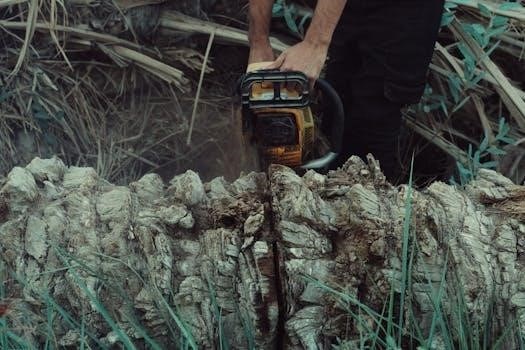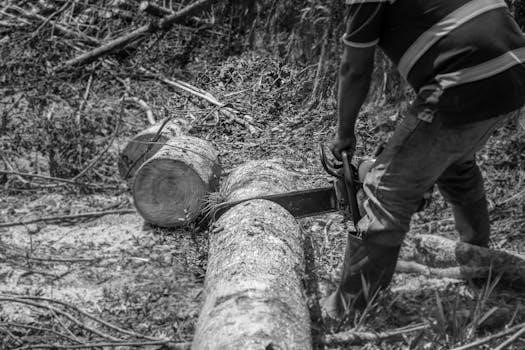
Chainsaw Guides⁚ A Comprehensive Overview

With the many types of chainsaws on the market today‚ shopping for your new power tool might feel a bit overwhelming․ But with the right chainsaw guide‚ you can easily cut through the noise and confusion to find the perfect saw for your next job․
Understanding Chainsaw Guide Bars
The chainsaw guide bar has the vital job of guiding the movement of the chain‚ which is the machine’s cutting element․ The bar and chain are the most important parts of your chainsaw․ A clean bar in good condition guides the chain through the cut‚ making a straight‚ true cut․
The guide bar’s cutting length‚ in addition to the chainsaw’s power rating‚ gives a general idea of what the chainsaw can do․ STIHL offers a full line of chainsaw guide bars for all types of use․ It depends on the model; a carving bar differs slightly from a standard guide bar․ Nevertheless‚ all types share similar․
Types of Chainsaw Guide Bars
Chainsaw guide bars come in various designs‚ each suited for specific applications․ These bar types are best suited to an application and usage pattern․ Bar types include solid guide bars with stellite tips‚ solid guide bars with replaceable nose sprockets‚ and laminated guide bars with fixed nose sprockets․
Carving bars are another specialized type․ STIHL offers a full line of chainsaw guide bars for all types of use from 10″ for specialized wood carving with small saws through 59″ for extreme felling operations․ Each of those chainsaw bar types is best suited to an application and / or usage pattern․
Solid Guide Bars
Solid guide bars are constructed from a single piece of high-grade steel‚ offering exceptional durability and resistance to bending or breaking․ These bars are designed for heavy-duty applications‚ such as felling large trees and working in demanding environments․ Some solid guide bars feature a Stellite tip‚ which is an extremely hard material that reduces wear and increases the bar’s lifespan․
Others have a replaceable nose sprocket‚ allowing for easy maintenance and replacement of the most vulnerable part of the bar․ Their robust construction makes them a reliable choice for professionals who require a bar that can withstand constant use․
Laminated Guide Bars
Laminated guide bars are constructed from multiple layers of steel that are bonded together‚ offering a balance of durability and weight․ These bars are commonly used in a wide range of chainsaws‚ from homeowner models to professional-grade saws․ The laminated construction allows for a lighter weight compared to solid bars‚ reducing operator fatigue during extended use․
Most laminated bars feature a fixed nose sprocket‚ which helps to reduce friction and improve chain speed․ While they may not be as robust as solid bars‚ laminated bars provide a good combination of performance and value for many cutting tasks․
Carving Bars
Carving bars are specifically designed for intricate wood carving and sculpting․ These bars are typically shorter and narrower than standard guide bars‚ allowing for precise control and maneuverability․ Carving bars often feature a narrow tip‚ which enables the user to create fine details and tight curves in their work․
These specialized bars are essential for artists and craftsmen who require a high degree of accuracy and finesse․ The design minimizes kickback and enhances control‚ making them ideal for creating detailed carvings․ Using a carving bar significantly improves the quality and precision of wood art projects․

Factors Influencing Guide Bar Choice
Selecting the right guide bar involves several key considerations to ensure optimal performance and safety․ The chainsaw’s power rating and the intended cutting length are primary factors․ A more powerful chainsaw can handle longer bars‚ increasing cutting capacity․ However‚ using a bar that’s too long for the chainsaw’s power can lead to reduced efficiency and increased wear․
Matching the guide bar length to the typical size of wood being cut is crucial․ Longer bars are suitable for felling large trees‚ while shorter bars are better for limbing and smaller tasks․ Personal experience and the specific needs of the job should also influence the decision․
Chainsaw Power Rating
The chainsaw’s power rating is a critical factor in determining the appropriate guide bar length․ A more powerful engine can drive a longer chain and bar more efficiently․ Using a bar that exceeds the chainsaw’s capacity can strain the motor‚ leading to reduced cutting speed and potential damage․
It’s essential to consult the manufacturer’s recommendations for guide bar length based on the chainsaw’s horsepower or engine displacement․ Matching the bar length to the power rating ensures optimal performance‚ prolongs the life of the chainsaw‚ and enhances safety by maintaining control during operation․ A balanced combination of power and bar length is crucial for effective cutting․
Cutting Length

The cutting length of a chainsaw guide bar dictates the maximum diameter of wood that can be safely cut in a single pass․ Selecting the appropriate cutting length is crucial for efficiency and safety․ Consider the typical size of logs and branches you’ll be cutting․
A longer bar allows for cutting larger diameters‚ but it also adds weight and can reduce maneuverability․ Shorter bars are lighter and easier to control‚ making them suitable for smaller tasks․ It’s important to balance the need for cutting capacity with the ease of handling‚ ensuring that the chosen bar length aligns with the intended applications of the chainsaw․
Chainsaw Chains⁚ A Detailed Guide
Chainsaw chains are the cutting component of a chainsaw‚ responsible for directly engaging with the wood․ Choosing the right chain is crucial for efficient and safe operation․ This guide provides a detailed overview of chainsaw chains‚ covering their types‚ sizes‚ and maintenance․
Understanding the different types of chains available‚ such as full chisel‚ semi-chisel‚ and low-profile chains‚ is essential for selecting the appropriate chain for specific cutting tasks․ Additionally‚ identifying the correct chain size‚ including pitch‚ gauge‚ and drive link count‚ ensures compatibility with your chainsaw․ Regular maintenance‚ including sharpening and replacement‚ is vital for maintaining optimal cutting performance and extending the lifespan of the chain․
Types of Chainsaw Chains
Navigating the variety of chainsaw chains can be confusing‚ but understanding the differences is essential for optimal cutting performance․ Chainsaw chains are categorized based on their cutter design‚ which directly impacts cutting speed‚ smoothness‚ and suitability for different types of wood․
The primary types include full chisel chains‚ known for their aggressive cutting and efficiency in clean wood; semi-chisel chains‚ offering a balance of cutting speed and durability‚ making them suitable for dirtier conditions; and low-profile chains‚ designed for safety and reduced kickback‚ ideal for beginners and smaller chainsaws․ Each type has its strengths and weaknesses‚ influencing the overall cutting experience․
Full Chisel Chains
Full chisel chains are known for their aggressive cutting action and high efficiency in clean wood․ These chains feature square-cornered cutters that slice through wood fibers with minimal resistance‚ resulting in faster cutting speeds and smoother finishes․ The design allows for rapid chip removal‚ preventing clogging and maintaining consistent performance․
However‚ the aggressive nature of full chisel chains makes them more susceptible to damage in dirty or abrasive conditions․ They require frequent sharpening to maintain their optimal cutting edge and are best suited for experienced users who can properly maintain and handle them․ Due to their aggressive nature‚ kickback may be more prevalent․
Semi-Chisel Chains
Semi-chisel chains offer a balance between cutting performance and durability‚ making them a versatile choice for a variety of applications․ These chains feature cutters with rounded corners‚ which provide a good compromise between cutting speed and resistance to dulling in abrasive conditions․ Semi-chisel chains are less prone to damage from dirt and debris compared to full chisel chains‚ making them suitable for cutting wood in less-than-ideal environments․
The rounded cutter design also reduces the risk of kickback‚ enhancing operator safety․ While semi-chisel chains may not cut as quickly as full chisel chains in clean wood‚ their increased durability and ease of maintenance make them a popular option for both professional and occasional users looking for a reliable all-around chain․
Low-Profile Chains
Low-profile chainsaw chains‚ also known as micro-chisel chains‚ are specifically designed with safety and ease of use in mind‚ making them an excellent choice for novice chainsaw operators and homeowners․ These chains feature a smaller cutter design and a shallower cutting angle‚ which significantly reduces the risk of kickback‚ a common cause of chainsaw-related injuries․
While low-profile chains may not offer the same aggressive cutting performance as full or semi-chisel chains‚ their enhanced safety features make them ideal for light-duty tasks such as pruning‚ limbing‚ and cutting small firewood․ The design prioritizes control and stability‚ allowing users to gain confidence and experience with a chainsaw while minimizing potential hazards․
Identifying Chainsaw Chain Size
Identifying the correct chainsaw chain size is crucial for ensuring optimal performance and safety․ Chainsaw chain size is determined by three key measurements⁚ pitch‚ gauge‚ and the number of drive links․ These measurements must match the specifications of your chainsaw to ensure proper fit and function․
The pitch refers to the spacing between the chain’s drive links‚ while the gauge measures the thickness of the drive links where they fit into the guide bar․ The number of drive links indicates the total count of these links in the chain loop․ Understanding these measurements allows you to select the appropriate replacement chain for your chainsaw‚ maximizing cutting efficiency and minimizing the risk of damage or injury․
Pitch
The pitch of a chainsaw chain is a critical measurement that determines the distance between the chain’s drive links․ Specifically‚ it’s the average distance between any three consecutive rivets on the chain‚ divided by two․ Common pitches include 0․325 inch‚ 3/8 inch‚ and 0․404 inch․
Selecting the correct pitch is vital because it must match the sprocket on your chainsaw․ Using the wrong pitch can lead to poor cutting performance‚ chain damage‚ and potential safety hazards․ Chainsaw manufacturers typically specify the appropriate pitch for each model in the owner’s manual‚ ensuring compatibility and optimal operation․ Always refer to this information when replacing your chainsaw chain․
Gauge
The gauge of a chainsaw chain refers to the thickness of the drive links‚ which are the parts of the chain that fit into the guide bar’s groove․ This measurement is crucial for ensuring the chain properly fits the chainsaw bar and operates safely․ Common gauges are 0․043 inch‚ 0․050 inch‚ 0․058 inch‚ and 0․063 inch․
Matching the correct gauge to your chainsaw’s specifications is vital for smooth and efficient cutting․ A chain with the wrong gauge can either be too loose‚ causing it to derail or vibrate excessively‚ or too tight‚ leading to increased friction and potential damage to the bar and chain․ Always consult your chainsaw’s manual or the manufacturer’s recommendations to determine the appropriate gauge for your equipment․
Drive Links
Drive links are the small‚ tang-like projections on the chainsaw chain that fit into the groove of the guide bar․ The number of drive links determines the length of the chain and ensures it properly fits the specific chainsaw model․ Counting the drive links on your existing chain is a reliable way to identify the correct replacement chain․
The number of drive links varies depending on the bar length and chainsaw model‚ so it’s essential to get this number right when purchasing a new chain․ An incorrect number of drive links will result in a chain that is either too long or too short to fit on the chainsaw․ Always double-check the drive link count before making a purchase to ensure compatibility․
Chainsaw Maintenance⁚ Chain Sharpening and Replacement
There’s nothing worse than a dull chainsaw chain․ Professionals swear by sharpening their chain regularly‚ often after each use‚ to maintain optimal cutting performance․ A sharp chain produces shavings‚ indicating efficient cutting‚ while a dull chain creates sawdust‚ signaling inefficiency and increased wear․ Regular sharpening not only improves cutting speed but also reduces strain on the chainsaw motor․
Like any serviceable part‚ a chainsaw chain will eventually wear out and require replacement․ When it’s time to replace your chain‚ it’s crucial to identify the correct size and type to ensure proper fit and function․ Always refer to your chainsaw’s manual or consult a professional for guidance on selecting the appropriate replacement chain;
Choosing the Right Chainsaw for the Job
Selecting the right chainsaw depends heavily on the tasks you intend to undertake․ Consider your personal experience; if you’re new to chainsaw work‚ opt for a smaller‚ more manageable saw․ A heavier chainsaw can quickly lead to fatigue‚ compromising safety and productivity․ Also‚ assess the size and type of wood you’ll be cutting․
For felling trees‚ a larger chainsaw with a longer guide bar and a more powerful engine is necessary․ Electric chainsaws are suitable for lighter tasks‚ and for the types of work that real people are doing in their yard‚ electric tools are plenty capable․
